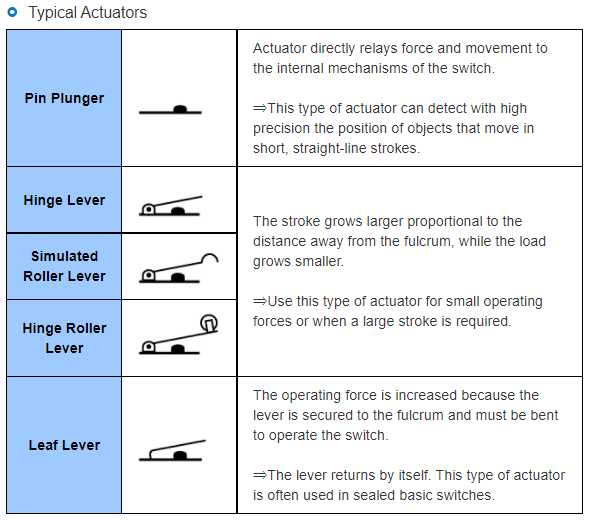What is an actuator?
ID: FAQE20010E
update:
Answer
An actuator is a component that transmits external force or movement to the internal mechanism of a basic switch. The mechanism consists of a pushbutton and lever.
Explanation
An actuator transmits external force and movement to the internal mechanism and is also useful for making the stroke longer and reducing the operating load (operating force) to make the switch easier to use. The table below shows their types.
Many different types of actuators can be attached to the actuator depending on the shape and movement of the detection object, based on a pin plunger. Select the actuator that is best suited for the shape and movement of the detection object.

For more details, see "What is a Basic Switch?" Structures.
Quick tips
Only V size switches have actuators (VAL, VAV, VAM) that can be mounted later.
| Product category | Switches Basic Switches |
|---|---|
| Classification | Selection, Characteristics |
| Related keywords |
|
Related Questions
-
Q
Can an actuator be incorporated later?
- A
Omron’s V size basic switches have optional actuators (VAL, VAV, VAM) that can be incorporated later.
-
Q
What are basic switches with a long stroke?
- A
The stroke of a basic switch is basically proportional to the size of the switch. Therefore, the longer (larger) the stroke of the basic switch you select, the larger the switch becomes. However, the lever actuator makes the stroke longer (larger) even if the switch is small. The longer the lever actuator is, the longer (larger) the stroke becomes while the smaller the OF (operating force) and RF (release force) become. As a result, when the OF is reduced, you need to select a lever actuator.
-
Q
How long does a basic switch last?
- A
Basic switches have electrical life (electrical durability) and mechanical life (mechanical durability).